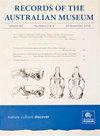昆士兰中部的Uromys化石(啮齿目:Murinae),描述了一个新的中更新世物种
IF 0.8
4区 生物学
Q4 ZOOLOGY
引用次数: 1
摘要
描述了Uromys(巨型裸尾鼠)的第一个化石物种,以及基于古生物学数据的该属最南端的记录。Uromys aplini sp.nov.生活在中更新世时期,位于昆士兰州中东部的埃特纳山附近,但可能在205卡之后但在90卡之前的某个时候因气候导致的栖息地丧失而灭绝。第二个物种,现存的C.caudimaculatus,在更新世晚期出现在该地区,但在最后一次冰川盛期之前在当地灭绝。这些化石表明,澳大利亚的Uromys物种的多样性出乎意料地高,这表明该大陆被长期占领。系统发育分析将aplini U和澳大利亚特有的其他Uromys物种放在该属辐射的基础上。这可能表明,Uromys最初的多样化发生在澳大利亚,而不是以前认为的新几内亚。Uromys的这些新的第四纪记录出现在该属最现代的南部记录以南约550公里处,表明Uromys能够穿越圣劳伦斯南部的生物地理屏障,可能在更新世期间两次。本文章由计算机程序翻译,如有差异,请以英文原文为准。
Fossil Uromys (Rodentia: Murinae) from central Queensland, with a description of a new Middle Pleistocene species
The first fossil species of Uromys (Giant Naked-tailed Rats) is described, as well as the southernmost records of the genus based on palaeontological data. Uromys aplini sp. nov. lived during the Middle Pleistocene in the area around Mount Etna, eastern central Queensland, but was probably driven extinct by climate-mediated habitat loss sometime after 205 ka but before c. 90 ka. A second species, the extant U. caudimaculatus, occurred in the area during the Late Pleistocene, but became locally extinct prior to the Last Glacial Maximum. These fossils indicate an unexpectedly high diversity of species of Uromys in Australia, suggesting a long occupation of the continent. Phylogenetic analysis places U. aplini together with other species of Uromys endemic to Australia, at the base of the radiation of the genus. This may indicate that the initial diversification of Uromys occurred in Australia rather than New Guinea, as has previously been thought. These new Quaternary records of Uromys occur approximately 550 km south of the southern-most modern record for the genus, indicating that Uromys was able to cross the southern St Lawrence biogeographic barrier, possibly twice during the Pleistocene.
求助全文
通过发布文献求助,成功后即可免费获取论文全文。
去求助
来源期刊
CiteScore
0.90
自引率
0.00%
发文量
9
审稿时长
>12 weeks
期刊介绍:
Records of the Australian Museum, volume 62 was published in 2010, volume 63 in 2011. Monographic works of particular significance are published irregularly as Records of the Australian Museum, Supplements (ISSN 0812-7387).

 求助内容:
求助内容: 应助结果提醒方式:
应助结果提醒方式:


